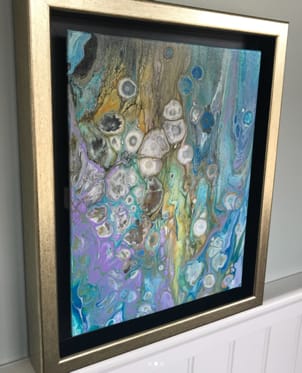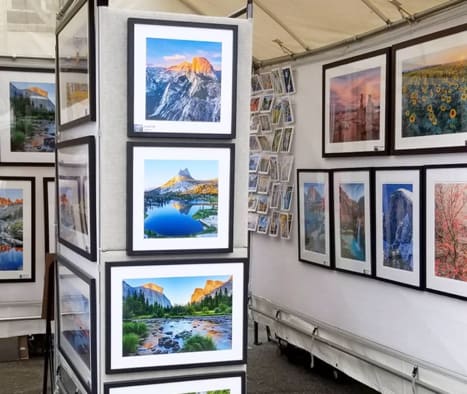How to Sell Your Art: 10 Tips for Artists
There’s nothing like inspiring someone with your art. It’s almost as great as selling your art to that person. If the selling part doesn’t come as naturally to you as the creating part, don’t worry. I’m here to help with tips I’ve learned both from being an artist myself and from my experiences with other artists as the co-owner of Frame Destination. These tips are designed to help you increase the value of your works and sell more art. Let’s get right to it.
1. Open Your Door (Studio or Online)
If you have a studio with foot traffic nearby, keeping your door ajar welcomes guests to walk right in. You’ll be surprised by the people you’ll meet and the unexpected sales you’ll make. Even if you don’t have a physical studio, keep your “digital door” open with social pages, a store through an online marketplace such as Etsy, or your own website that others can help you promote.
2. Make the Most of Art Trends
If you’re grimacing, hear me out. Developing your own unique artistic style is imperative, and I agree that your work shouldn’t be subject to the latest craze. However, trends sell, and you can leverage them while staying true to your work.
For example, trending icons, patterns, colors, etc. in fashion and home decor created in your style could be an interesting challenge that might even attract new customers. Trends in frame finishes are something else to watch for. A popular distressed black or white picture frame may add character to an urban art installation or a rustic canvas floater frame might be a perfect complement to a farmhouse or landscape painting. Browse decorating magazines, visit local retail shops, or experiment with Pantone’s color of the year for ideas.


Photographer, Kevin Holliday, has a well-designed branded certificate he includes with each of luxury fine art prints. It includes details about the work as well as an artist statement. Even if yours is a much simpler version, a certificate of authenticity increases buyer confidence, gives buyers a little extra knowledge about the piece, and allows them to envision your art as an investment and complement to their collection.
4. Be Confident in Pricing Your Artwork or Ask for Help
Even the most talented artists can get rattled when customers try to negotiate price at an art show. This is normal! Our artworks are our babies, and pricing something precious isn’t easy. If you’re finding it difficult to stick with what your art is worth, try this: Enlist a friend who believes in your art and can either stand firm with justification or negotiate with clients. You can trade out services if you don’t have the cash to pay them. It will be well worth it!
5. Know the Power of Quality Art Framing and Components
Whether you need ready made frames or want to create a custom picture frame to your exact specifications, quality framing adds value to your work so don’t settle for less. Pricing confidence comes more easily when you have high-quality, precision components that are professionally crafted and tailored for your art. As photographer Kevin Holliday shared:
“For my solo exhibition this past summer, I leaned on Frame Destination to cut the mats for me. I will typically handle these things myself, but for 24 prints that were all going to be framed with very finicky 8-ply cotton mats, I felt it would be best to outsource that part of the process. I am extremely thrilled with how well they turned out…and I’m a VERY picky customer.”
Kevin sold four prints on opening night and offered this feedback to us:
“I had more comments than I can remember…many of these comments had to do with the product, not the image itself!!! It was truly wonderful to hear people comment on how closely I pay attention to all the small details. Bottom line is that I’m selling Mercedes and Audi’s, not Honda’s and Toyota’s…people take note of quality when they see it, and they are willing to pay for it. So again, I appreciate all that you did to help in that regard.”

6. Show Off Your Artistic Style
Like in the movie, Jerry Maguire, your art should say to its frame, “You complete me.” But make sure it’s the right style for your work, enhancing and complementing your art. Choose the gallery style option for framing to highlight the art, the non-gallery style to use the frame package as an extension of the art, or explore these tips for choosing between a wood or metal frame for your art.
Taking home a framed work can motivate buyers. It’s perfect and ready to be displayed. They can already envision where it will go. Just make sure your art is the main attraction, and the components showcase it best.
Image courtesy of @byramshorestudio
7. "KISS: Keep It Simple for Shows."
Our spin on the traditional KISS method reminds us that choosing the same frame, mat, and (if possible) size for gallery or art shows can be a great way to reduce your cost and stress levels. Keeping things uniform will also reinforce your signature style, plus helps you take advantage of volume discounts.

Can you break this rule? Absolutely. While I advocate the KISS method for framing art, I’ve been happily proven wrong on a few occasions. For example, one of our customers had striking monochromatic floral photographs that were printed on metal, framed in a simple silver metal frame, and not selling particularly well. We worked with him to choose mat boards in various, complementary colors that made his artwork pop — and sell in high volume.
Image courtesy of @pecherskyyphotography
8. Go Frameless
Some potential customers can’t afford a framed piece or may be away from home when shopping and don’t want to travel with a bulky piece. Offer them alternatives such as matted prints in clear bags. Another option is gallery wrapping, where artwork is stretched and affixed onto stretcher bars.
And be sure to preserve the value of your art by transporting it to and from shows using a unique, reusable protective GalleryPouch. You can even offer them to your vacationing buyers to assist them in getting their art home safe and make a few extra bucks.
9. Learn More About the Business of Art
One of my favorite resources is Alyson Stanfield’s website. I also highly recommend her book, I'd Rather Be in the Studio! The Artist's No-Excuse Guide to Self-Promotion. In addition, I love Art Inc. by Lisa Congdon.
10. Expose Yourself, in a Good Way
Connect with your audience through societies, non-profit groups, niche galleries, or even coffee shops where those that may have an interest in your subject matter hang out. But don’t stop there. As part of our brand promise, Advocacy for Artists, we can help expose you and your work through our social pages’ hashtag #framedestination and our artist spotlight blog series, Artie’s Eight. Ready for the spotlight? Apply today.
Selling art combines creativity and good business sense. At Frame Destination, we understand the importance of this balance. Kevin Holliday called us “a team of artisans that truly cares,” and we couldn’t be more proud to support artists like Kevin in our creative community. What other tips have helped you sell more art? Or if these tips have inspired you, we welcome your comments below.
Last Updated April 21, 2024
Written by Joely Rogers
 Joely C. Rogers is an artist/illustrator and writer living in the mountains of western North Carolina. She has professional training in both natural science illustration and the culinary arts, as well as graduate academic training in education, sociolinguistics, and folklore/storytelling. She is a Blue Ridge Naturalist candidate with the North Carolina Arboretum and a member of the Guild of Natural Science Illustrators.
Joely C. Rogers is an artist/illustrator and writer living in the mountains of western North Carolina. She has professional training in both natural science illustration and the culinary arts, as well as graduate academic training in education, sociolinguistics, and folklore/storytelling. She is a Blue Ridge Naturalist candidate with the North Carolina Arboretum and a member of the Guild of Natural Science Illustrators.